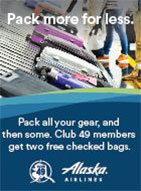|
Fish Factor Weaker dollar good news for Alaska's overseas seafood businessBy LAINE WELCH August 20, 2017
While that may sound like a bad thing, it’s great news for Alaska seafood and anyone doing business overseas. “It’s a good thing for Alaska seafood producers because roughly two-thirds of the value of our seafood comes from export markets. So when our currency is less valuable, the prices are not as high for foreign buyers,” said Andy Wink, senior fisheries economist with the McDowell Group. It’s a turn-around for a strong dollar that has for several years made Alaska seafood very pricey for prime customers of Japan, Europe and the UK. Now they will be inclined to buy more for less. Americans aren’t so lucky. The weaker dollar makes the cost of imported goods more expensive here at home – including the 85 percent of seafood that’s imported into the US each year. “A five percent swing or whatever it is in the value of the dollar will probably make seafood more expensive, “Wink predicted. The weakening dollar is due to uncertainties by global banks and investors about the Trump administration and its ability to accomplish promises of health care reform, raising interest rates, massive tax cuts and infrastructure spending. Many analysts also point to big question marks looming over Trump’s trade policies. “It’s the way that investors perceive the health of the U.S. economy,” Wink said. Still - the dollar losing its mojo couldn’t come at a better time for Alaska salmon sales. “Where we are now,” he added, “is a lot better than where we were at this time last year.” Cameras count fish: Cameras can now track what’s coming and going over the boat rails instead of human fishery observers. Starting in 2018 a new law allows for electronic monitoring systems to be used on smaller boats between 40 and 60 feet, and boats harvesting Alaska halibut. The voluntary EM option is open to longline vessels and boats fishing with pot gear, and the chance to get some extra bunk space back is a big relief for the fleet. “Taking a human observer is simply not practical for those boats in terms of space or life raft capacity. I was really glad to see we finally got it on the books,” said Dan Falvey, program director for the Sitka-based Alaska Longline Fishermen’s Association (ALFA). Small boat fishermen, which make up the majority of Alaska’s fishing fleet, also had a hard time with escalating observer costs which could range from $300 to $1,000 per day. Boats aligned with ALFA and the Homer-based North Pacific Fisherman’s Association tested the EM program and protocols for several years as part of the ‘pre-implementation phase.’ The camera system proved it could track and identify over 95 percent of species required for fishery management decisions. Currently, more than 70 Alaska longliners and 18 pot boats are in the EM pool, and Falvey said managers have approved expanding it to include 120 longline and 45 pot boats over the next few years. By all accounts, the on-deck camera systems are reliable and user friendly. “They are just like any other piece of marine electronics on a boat,” Falvey explained, adding that it takes about a day and a half to install. “Skippers do a small functions test to make sure it’s working properly and if it passes the test, the vessel is free to go fishing. If the EM system leaves town working and they have problems on the water, they don’t have to end their trip. That is a really important part of the program.” Also - the cameras come on only when you’re fishing. “The systems turn on when your hydraulics activate. The camera is rolling continuously while you’re hauling back and for a couple hours after to watch the sorting on deck. Then they turn off until the next time you turn on your hydraulics,” Falvey said. When a boat gets back from a fishing trip, the skipper pulls the hard drive and mails it to the Pacific States Marine Fisheries Commission for review. The EM systems, valued at $8,000 - $10,000, come at no cost to Alaska fishermen. Start-up funds for the hardware and installation were provided by the National Fish and Wildlife Foundation, and the program is covered by fishermen’s fees. “In Alaska, the EM system is provided to the boat as part of the observer program and paid for as part of the 1.25 percent fee we all pay,” Falvey said. All boats planning to participate in the EM program in 2018 must register with the Observer Declare and Deploy System (ODD) starting September 1 through November 1. Questions? Call 1-855-747-6377. Dungy dive: Southeast Alaska’s biggest crab fishery has taken a dive this year with shortened fisheries for the summer and the fall. The summer fishery, which produces nearly three-quarters of the annual catch, landed just 1.3 million pounds of dungies, the lowest in more than 30 years. Managers cut the fishery short by three weeks in late July when crab catches were not meeting set thresholds, the second early closure in 15 years. The fall Dungeness season also will be clipped by a month. State managers announced that it will open as usual on October 1 but will close October 31, instead of running through November. Late molting is a likely cause of the lower catch numbers, said biologist Kelli Wood at the Alaska Dept. of Fish and Game office in Petersburg. Large numbers of the crabs pulled up in the summer pots were soft shelled, meaning newly molted, and likely hid out from the fishery. “It could be due to the fact that the crabs were just ‘not on the bite.’ After they molt they bury in the mud and don’t come out and they are not hungry. If it was a later molt, they probably would be buried from the fishery,” Wood told KFSK in Petersburg. Biologists are uncertain about the timing and frequency of the crab’s molting habits because no surveys are done on the Dungeness stocks. Managers rely instead on information from commercial fisheries to track the crab. In 2015, Southeast crabbers landed more than five million pounds of Dungeness and averaged $2.95 a pound. The crab fishery was worth $15 million to the region.
Laine Welch ©2017 Laine can be reached
at msfish[AT]alaska.com
Representations of fact and opinions in comments posted below are solely those of the individual posters and do not represent the opinions of Sitnews.
SitNews ©2017 Stories In The News Ketchikan, Alaska
|
|||





